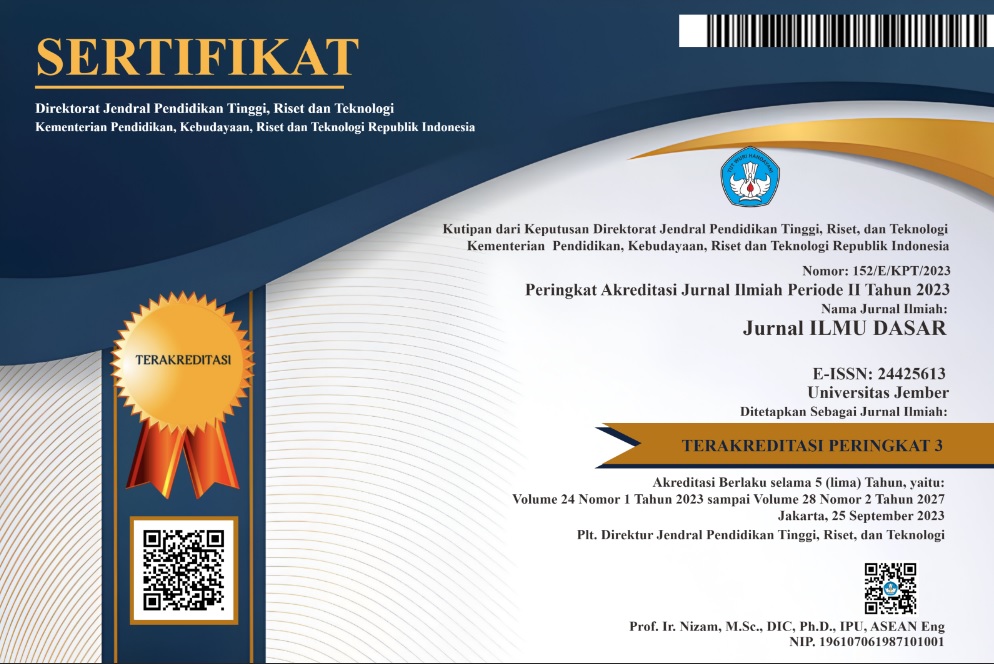Diversity Species and Structure of Mangrove Vegetation in Conservation Forest and Angke Nature Park North Jakarta
DOI:
https://doi.org/10.19184/jid.v25i2.34761Keywords:
Ecosystem, Mangrove, VegetationAbstract
Mangrove is important life support ecosystems in coastal and marine areas that have bio-ecological and socio-economic functions. Mangroves are found in tidal areas that have the ability to grow in salty waters and have a role as a barrier to abrasion. Mangrove plants have special adaptability to the environment such as adaptation to low oxygen levels, high salinity and less stable soils. Indonesia has the largest mangrove ecosystem and the highest biodiversity in the world. This study aims to determine the index of diversity and structure of mangrove communities in Hutan Lindung Angke-Kapuk (HLAK) and Taman Wisata Angke (TWA) Angke-Kapuk which is divided into 11 points. The research was carried out on November 15 to 30, 2021 using purposive sampling techniques based on the representation element, which took 5% of the total area and the shape of a square plot with a size of 50x50 meters. The results showed that 11 family, 12 genus and 15 species of mangroves were found, the type was divided into 8 species of true mangroves and 7 species of mangroves followed. The extinction rate of mangrove species in HLAK and TWA Angke-Kapuk amounted to 1.25. The level of type similarity between research points in the HL Angke-Kapuk and TWA Angke Kapuk areas in 2020 and 2021, showed a slight change in the level of type similarity at each point. The dominant type of seedling and sapling tree level is the Avicennia marina type. Mangrove diversity index (H’) in the area of HLAK and TWA Angke Kapuk is 1.6.
Downloads
References
Atmawidjaja R & Romimohtarto K. 1998. Keberadaan Mangrove Dan Permasalahan Permasalahannya Kasus Cagar Alam Muara Angke. Prosiding Seminar VI Ekosistem Mangrove. Riau.
Avenzora R. 1988. Evaluasi Cagar Alam Muara Angke Jakarta. Bogor: Jurusan Konservasi Sumber Daya Hutan, Fakultas Kehutanan IPB.
Chapman V. 1977. Wet Coastal Ecosystems. Ecosystems of the World: 1. Elsevier Scientific Publishing Company.
FAO. 1982. National Conservation Plan For Indonesia. Vol II dan III. Bogor: WWF-FAO.
Hakim L. 2007. Keanekaragaman Jenis Dan Struktur Komunitas Tumbuhan Mangrove Di Kawasan Hutan Lindung Angke-Kapuk, Muara Angke, Jakarta Utara. Jakarta: Fakultas Biologi Universitas Nasional.
Indriyanto. 2006. Ekologi Hutan. Jakarta: Bumi Aksara.
Kint A. 1934. De luchtfoto en de Topografische Terreingesteldheid in De Mangrove, 23: 173-189. De Tropische Natuur.
KLHK. 2017. Miliki 23% Ekosistem Mangrove Dunia, Indonesia Tuan Rumah Konferensi Internasional Mangrove 2017. Diambil kembali dari Kementerian Lingkungan Hidup dan Kehutanan PPID: ppid.menlhk.go.id/siaran_pers/browse/561
Kusmana C. 1997. Konsep Pengelolaan Terpadu Kawasan Cagar Alam dan Hutan Lindung Muara Angke. Prosiding Worshop Pengelolaan Terpadu Kawasan Cagar Alam dan Hutan Lindung Muara Angke-Kapuk, Jakarta Utara. Bogor.
Macnae W. 1968. A General Account of the Fauna and Flora of Mangrove Swamps aand Forests in Indo-West-Pasific region. Pp. 73270 in Advances in Marine Biology Volume 6. London: Academic Press.
Magurran A. 1987. Ecology Diversity and its New Jersy: Measurement.
Mueller, Dumbois & Dieter. 1974. Aims And Method Of Vegetation Ecology. Toronto: John Welley & Son Inc.
Noor YR, Khazali M & Suryadiputra I. 2006. Panduan pengenalan mangrove di Indonesia. Cetakan ke-2. Bogor.
Odum E. 1996. Dasar-Dasar Ekologi. Yogyakarta: Gadjah Mada University Press.
Purnobasuki H. 2005. Tinjauan Perspektif Hutan Mangrove. Surabaya: Airlangga University Press.
Setiadi D. 2004. Keanekaragaman Spesies Tingkat Pohon di Taman Nasional Alam Ruteng, Nusa Tenggara Timur. Biodiversitas. 6: 118-122.
Smeins F & Slack R. 1982. Fundamentals of Ecology Laboratory Manual. Dubuque: 2nd ed. Kendall/Hunt Publishing Company.
Soegianto A. 1994. Ekologi Kuantitatif: Metode Analisis Populasi dan Komunikasi. Jakarta: Usaha Nasional.
Van Steenis C. 1958. Ecology of Mangroves. Introduction to Account of the Rhizophoraceae by Ding Hou. Flora Malesiana Ser. I, 5: 431- 441.








